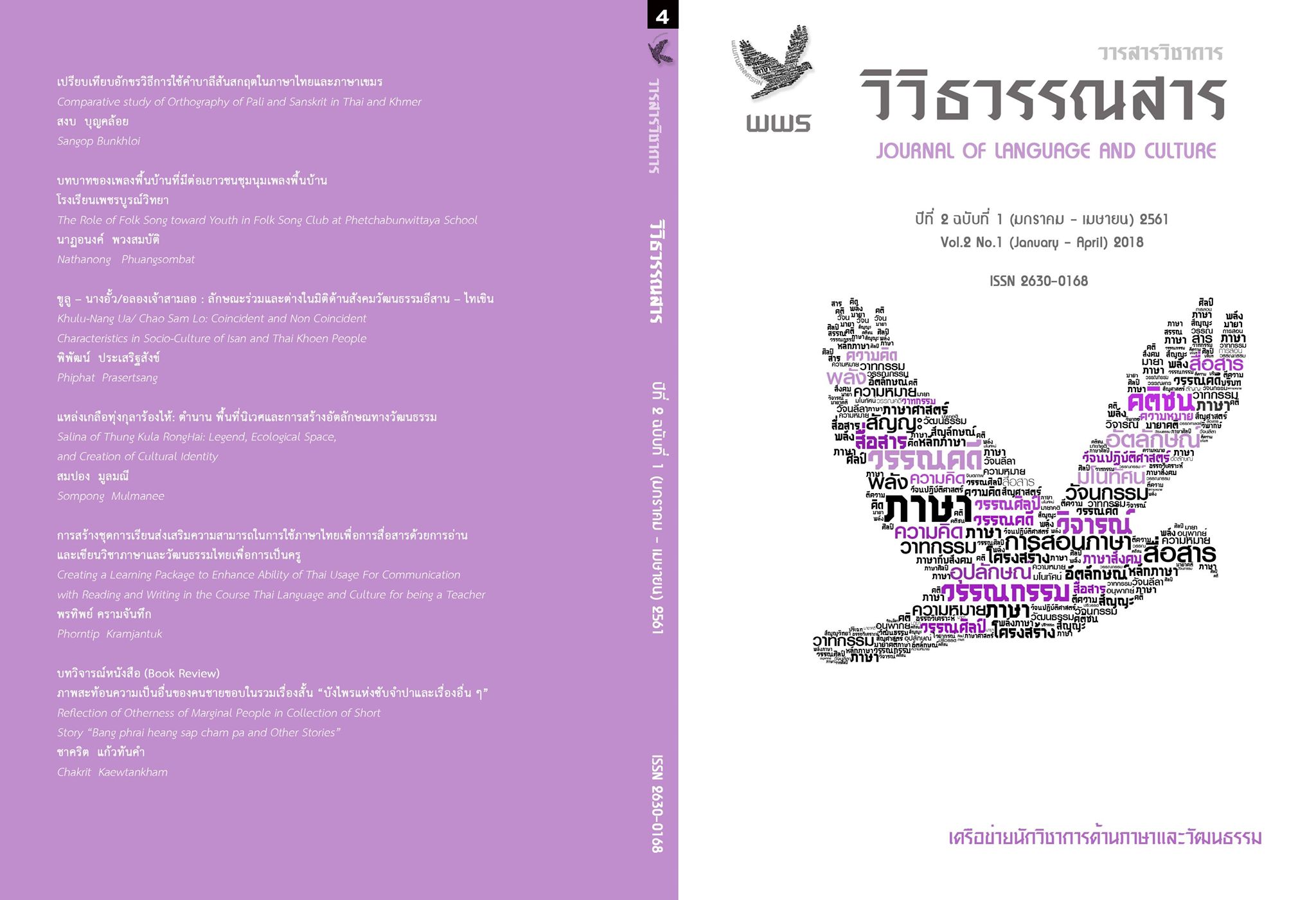ขูลู – นางอั้ว/อลองเจ้าสามลอ : ลักษณะร่วมและต่างในมิติด้านสังคมวัฒนธรรมอีสาน – ไทเขิน
Main Article Content
บทคัดย่อ
บทความวิชาการนี้มีวัตถุประสงค์เพื่อศึกษาลักษณะร่วมและต่างในมิติด้านสังคมวัฒนธรรมอีสาน – ไทเขิน ผ่านวรรณกรรมเรื่อง ขูลู – นางอั้วและอลองเจ้าสามลอ ผลการศึกษาพบว่า 1). ภาพสะท้อนสังคมในวิถีชีวิตของคนอีสานและคนไทเขิน 1.1 ด้านการเมืองการปกครอง ปกครองด้วยระบอบราชาธิปไตย โดยมีพระเจ้าแผ่นดินอยู่เหนือกฎหมายอำนาจสูงสุดเป็นของพระเจ้าแผ่นดินเพียงผู้เดียว การใช้อำนาจอธิปไตยของเจ้าเมืองมีลักษณะที่ไม่ก่อให้เกิดความเดือดร้อนแก่ประชาชน 1.2 ด้านสภาพเศรษฐกิจ / อาชีพ มีการดำเนินชีวิตโดยการประกอบอาชีพแบบพึ่งพิงธรรมชาติแวดล้อมบนหลักพึ่งพาตนเองโดยการปรับตัวให้เข้ากับธรรมชาติ 2). ภาพสะท้อนขนบประเพณีวัฒนธรรมในวิถีชีวิตของคนลาวอีสานล้านช้าง – ไทเขิน 2.1 ด้านการแต่งกาย คนอีสานที่มียศถาบรรดาศักดิ์จะแต่งกายด้วยผ้าไหม ฝ่ายชายจะนุ่งโสร่ง สวมเสื้อแพรไหม ฝ่ายหญิงจะนุ่งซิ่นไหม ห่มผ้าแพรไหมส่วนไทเขินการแต่งกายของหญิงสาวผู้มีฐานะมีการสวมสร้อยสังวาล ปิ่น ลานหูหรือต่างหูที่ล้วนทำด้วยทองคำ 2.2 ด้านประเพณีการเกี้ยวพาราสี ภาคอีสานมีวัฒนธรรมประเภทหนึ่งที่เรียกว่าผญาเกี้ยวพาราสี เป็นผญาที่คนอีสานสมัยก่อนได้แต่งและคิดขึ้นเพื่อใช้เป็นเครื่องมือสื่อสารรักระหว่างบ่าวสาว ส่วนไทเขินจะมีการแอ่วสาว เป็นการเล่นดนตรีของหนุ่ม ๆ ที่ไปแอ่วสาว 3 อย่าง คือ สะล้อ ซึง ปี่ และขับทำนองเสนาะในเชิงเกี้ยวพาราสีเมื่อเวลาออกจากที่พักไปหาหญิงสาวคนรักในเวลากลางคืน 2.3 ด้านการสู่ขอ คนอีสานมีประเพณีการโอมสาว คือ การสู่ขอสาว เมื่อชายหญิงได้ตกลงปลงใจที่จะอยู่ร่วมกันอย่างแท้จริงแล้ว ฝ่ายชายต้องจัดให้ญาติผู้ใหญ่ของตนไปสู่ขอต่อพ่อแม่ฝ่ายหญิงโดยมีสิ่งของบรรณาการ ชาวไทเขินมีประเพณีการสู่ขอหมั้นหมาย และมีการใช้เงินทองเป็นสินสอดของหมั้น เมื่อมีการตกลงกันได้ก็จะมีการกำหนดวันเดือนที่จะให้มีพิธีแต่งงานต่อไป 2.4 ด้านงานศพ สะท้อนลักษณะร่วมในการจัดงานศพของชนชั้นปกครองที่ยิ่งใหญ่สมเกียรติ ในระหว่างงานศพนั้นมีประเพณีการเสพงันและการละเล่น
Article Details
ลิขสิทธิ์ของบทความเป็นของวารสาร การพิมพ์ซ้ำจะต้องได้ร้บการอนุญาตจากบรรณาธิการวารสาร
เอกสารอ้างอิง
Sivilcultural Research Section, Maintenance Division, Forest Department, Ministry of
Agriculture and Cooperatives. pp.290-298
Charoen Sin Olan, C. (2002). Amnat rai phrom daen: Phasa wathakam chiwit racham wan
lae lok thi plianplaeng. (in Thai) [Unlimited Power: Language, Discourse, Daily Life and
Changing World]. Bangkok: Wiphasa.
Hongsuwan, P. (2005).The Buddha relics myths of the Tai peoples: significance and
interaction between Buddhism and in digenous beliefs. Doctoral Thesis, Graduate
School, Chulalongkorn University.
Kheandi, T. (2516, July, 23). Personal Interview.
Kong Sap, S. (2003). Tamnan Thung Kula Ronghai. (in Thai) [Legend of Thung Kula Ronghai],
Journal of Cho Chomsurin. 2 (9) : 323-33.
PhianCharoen, C (1972). Laeng kluea nai phaktawan-ok chiangnuea. (in Thai) [The Salt
Resource in the Northeast]. Journal of Saichon, 4 (2).13-15.
SomAsa, K. (2009). Kan to rong choeng amnat phuea kan chat kan sapphayakon
thammachat khong chao chum chon Bo Phan Khan. (in Thai) [Power Negotiation for
Natural Management of People of Bo Phan Khan Community]. Doctoral Thesis, Program
in Thai Studies, Mahasarakham University.
Walliphodom,S. (2008). Khwam mai khong phum watthanatham kan sueksa chak phai nai
lae samnuek khong thong thin. (in Thai) [Meaning of Geo–culture: An Internal Study
and Awareness of Locality]. Bangkok: Lek-Prapai Wiriayahpan Foundation.
Walliphodom, S. (1978). Isan nai rawang satawat thi 12-16. (in Thai) [Isan during 12-16
Century]. Journal of Isan Heritage: history and Archeology. (np).
Walliphodom, S. (1990). Isan laeng arayatham. (in Thai) [Isan: Source of Civilization].
Bangkok: Matichon.
Walliphodom, S. (1992). Kan anurak moradok thang watthanatham lae
kan sangsan sing mai tham klang krasae kan plian plaeng. (in Thai)
[Conservation of Cultural Heritage and Innovation amidst of Change
Flow. ] In Seminar on Evaluation in Culture: A Case of South. Bangkok:
Office of National Cultural Commission.
Wongthet, S. (2015). Roi Et ma chak nai. (in Thai) [Origin of Roi Et]. Bangkok: Bangkok Bank.
Wongthet, S. (2015). Thung Kula 2,500 pi ma laeo aeng arayatham Suwannaphum nai
Asian. (in Thai) [Thung Kula for 2500 Years was the Source of Suwannabhumi
Civilization in ASEAN. Bangkok: Matichon Publishing House


